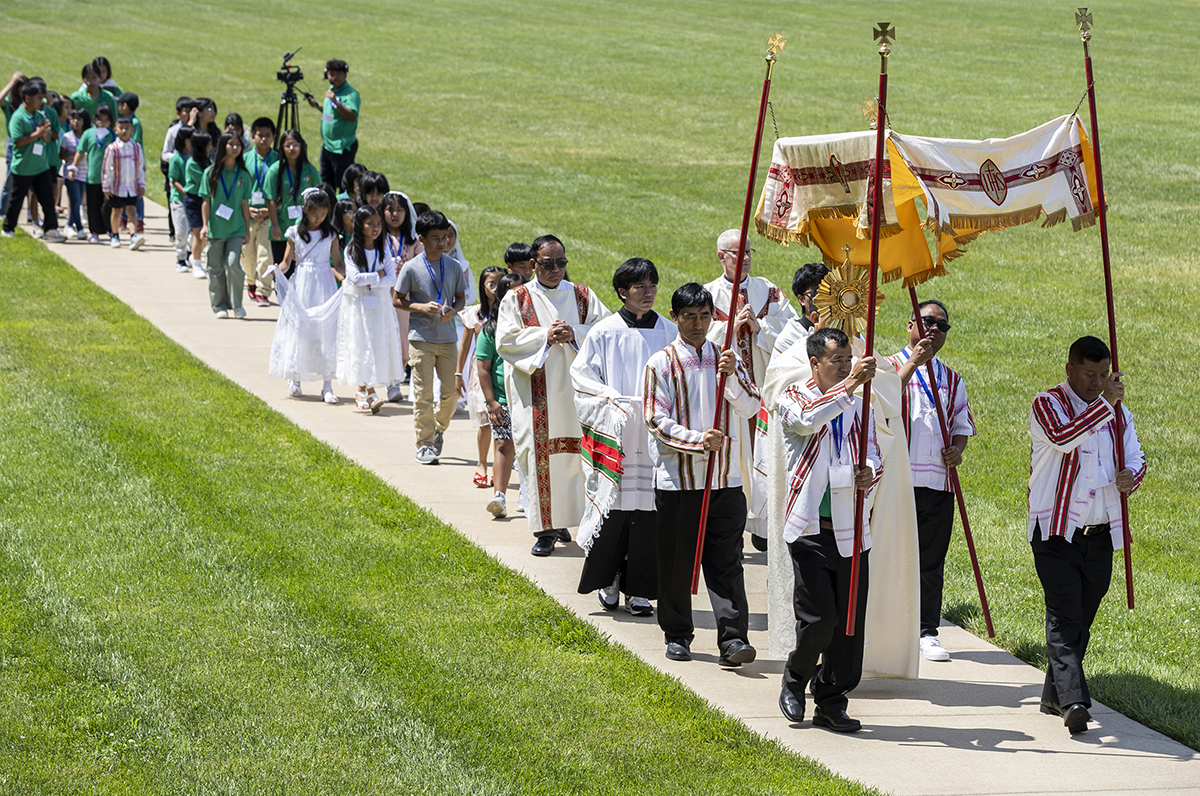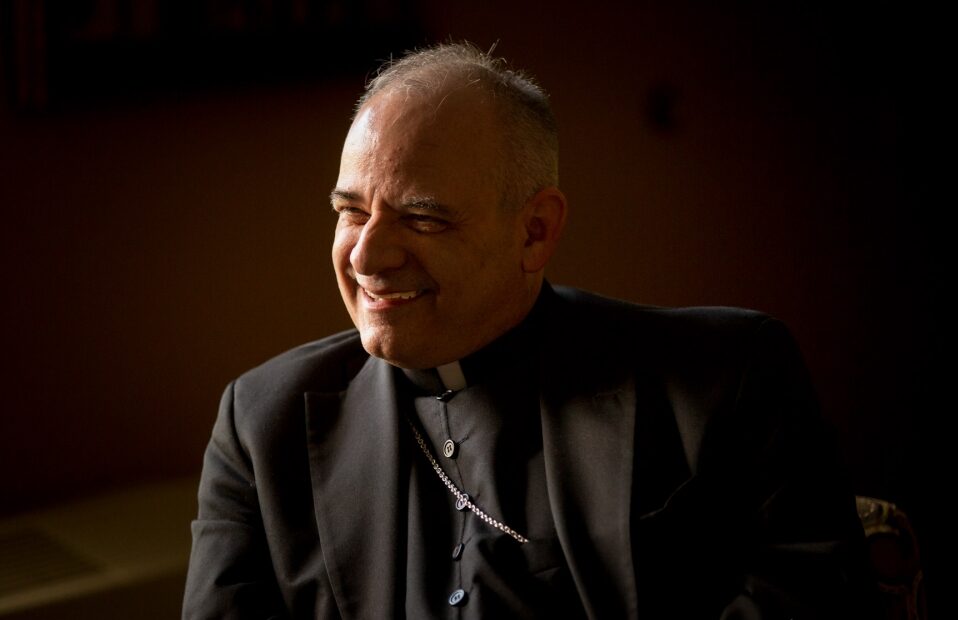Maronites celebrate Bishop Shaheen’s ‘extraordinary life’
Bishop Robert J. Shaheen, American-born, Lebanese bishop who served in St. Louis for a half of a century, died Aug. 9
Updated Aug. 17
Bishop Robert J. Shaheen, the first Maronite priest to be ordained in the United States and a priest and bishop in St. Louis for a half-century, died Aug. 9. Bishop Shaheen, who celebrated his 80th birthday in June, was the second bishop of the Eparchy of Our Lady of Lebanon of Los Angeles, headquartered in St. Louis. He retired in 2013.
A celebration of the Divine Liturgy (funeral) was held Aug. 16 at St. Raymond Maronite Cathedral in St. Louis. He will be buried Monday, Aug. 21, from St. Anthony Maronite Church in his hometown of Danbury, Conn.
“We pray for the repose of his soul, and give thanks to God for all of the lives that Bishop Shaheen has touched in his extraordinary life” said Bishop A. Elias Zaidan, current bishop and successor to Bishop Shaheen.
“I am saddened to hear of the passing of Bishop Robert J. Shaheen, a good friend and a beloved shepherd of the Maronite Catholic community,” Archbishop Robert J. Carlson stated. “I ask that the faithful of the Archdiocese of St. Louis join me in praying for the repose of the soul of Bishop Shaheen. Bishop Elias Zaidan and the faithful of the Eparchy of Our Lady of Lebanon of Los Angeles will continue to be in our thoughts and prayers. May his soul, and the souls of all the faithful departed, rest in peace.”
Born to Albert and Aileen Shaheen in Danbury, he attended St. Peter Grammar School and Danbury High School before entering the Latin Church St. Thomas Seminary in Bloomfield in 1955. In 1958, he transferred to the Eastern rite St. Basil Seminary in Methuen, Mass., while attending classes at St. Anselm College in Goffstown, N.H.
After being ordained a subdeacon (Oct. 2, 1962) and deacon (June 7, 1963), Bishop Shaheen was ordained a priest by Bishop Francis Mansour Zayek on May 2, 1964, at the Basilica of the National Shrine of the Immaculate Conception. Shortly after his ordination, he became pastor of St. Raymond’s Church in St. Louis, which had been without a resident priest for more than 20 years. Under his leadership, St. Raymond’s went from just a few faithful parishioners using a four-family apartment to a cathedral with hundreds of active families.
From 1965-70, he organized and celebrated Maronite liturgies on a regular basis. He also developed newsletters, bulletins, and fliers; conducted a census to identify Maronites in the greater metropolitan area; and introduced spiritual and cultural programs, including Maronite religious education classes. He hosted the National Apostolate of Maronites Convention in 1970. Kicking off a fund drive for a new church in 1971, he later dedicated the new church in November 1975 and a new rectory in February 1977. He was ordained an archpriest in September 1978, and dedicated a new parish center, The Cedars, in November 1979.
In 1986, Shaheen was ordained a chorbishop by Archbishop Zayek. He purchased additional property and buildings for future development as a Maronite retirement center and cultural center in 1991, and again hosted the National Apostolate of Maronites Convention in 1995.
On Dec. 5, 2000, Bishop Shaheen was appointed Eparch of the Eparchy of Our Lady of Lebanon by St. Pope John Paul II, following the retirement of Our Lady of Lebanon’s first bishop, John George Chedid. He was consecrated a bishop on Feb. 15, 2001 by Nasrallah Boutros Sfeir, the Patriarch of Antioch and All the East at the Cathedral Basilica of St. Louis.
Bishop Shaheen retired in 2013. Bishop Zaidan succeeded him as the third bishop of the Eparchy of Our Lady of Lebanon of Los Angeles.
Bishop Shaheen was known for revitalizating the LaSalle Park neighborhood on the near southside of St. Louis, where the cathedral is located. He led the parish through a large capital program, including the construction of a new church, rectory, hall and eparchal center over the years of his pastoral ministry.
He also had a longstanding interest and concern for the well-being of Christians in the Middle East during the Syrian conflict.
Lebanon in particular has been heralded as an example of peace in the Middle East, he said prior to a 2013 visit to Lebanon. “Lebanon has always been a country that has accepted all sorts of persecuted people,” he said. “It’s a place where Christians and Muslims live together with no difficulty. They go to the same schools, live in the same villages. Even today, as a Maronite Catholic bishop, I could go into a Muslim (owned) restaurant and I would receive a warm welcome. Lebanon has always had that idea of tolerance, of equality.”
Updated Aug. 17 Bishop Robert J. Shaheen, the first Maronite priest to be ordained in the United States and a priest and bishop in St. Louis for a half-century, died … Maronites celebrate Bishop Shaheen’s ‘extraordinary life’
Subscribe to Read All St. Louis Review Stories
All readers receive 5 stories to read free per month. After that, readers will need to be logged in.
If you are currently receive the St. Louis Review at your home or office, please send your name and address (and subscriber id if you know it) to subscriptions@stlouisreview.com to get your login information.
If you are not currently a subscriber to the St. Louis Review, please contact subscriptions@stlouisreview.com for information on how to subscribe.






